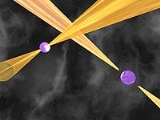
PSR J0737-3039
Overview
| Distance
Cosmic distance ladder
The cosmic distance ladder is the succession of methods by which astronomers determine the distances to celestial objects. A real direct distance measurement of an astronomical object is possible only for those objects that are "close enough" to Earth...
| 1600 - 2000 Ly (600 parsecs)
PSR J0737-3039 is currently the only known double pulsar
Pulsar
A pulsar is a highly magnetized, rotating neutron star that emits a beam of electromagnetic radiation. The radiation can only be observed when the beam of emission is pointing towards the Earth. This is called the lighthouse effect and gives rise to the pulsed nature that gives pulsars their name...
, it consists of two neutron stars
Neutron star
A neutron star is a type of stellar remnant that can result from the gravitational collapse of a massive star during a Type II, Type Ib or Type Ic supernova event. Such stars are composed almost entirely of neutrons, which are subatomic particles without electrical charge and with a slightly larger...
emitting electromagnetic waves in the radio wavelength in a relativistic binary system
Binary system
Binary system may refer to:* Binary numeral system, the base-2 internal "machine language" of computers* Binary opposition, a bipolar distinction in philosophy, structuralism and critical theory...
. The two Pulsars are known as PSR J0737-3039A and PSR J0737-3039B. It was discovered in 2003 at Australia's Parkes Observatory
Parkes Observatory
The Parkes Observatory is a radio telescope observatory, 20 kilometres north of the town of Parkes, New South Wales, Australia. It was one of several radio antennas used to receive live, televised images of the Apollo 11 moon landing on 20 July 1969....
by an international team led by the radio astronomer Marta Burgay
Marta Burgay
Dr Marta Burgay is a radio astronomer whose initial claim to fame was being the discoverer of PSR J0737-3039, the first double pulsar , through using the 64-metre Parkes radio telescope in Australia.-J0737–3039:...
during a high-latitude pulsar survey.
A pulsar is the collapsed core of a star
Star
A star is a massive, luminous sphere of plasma held together by gravity. At the end of its lifetime, a star can also contain a proportion of degenerate matter. The nearest star to Earth is the Sun, which is the source of most of the energy on Earth...
that has ended its life as a supernova
Supernova
A supernova is a stellar explosion that is more energetic than a nova. It is pronounced with the plural supernovae or supernovas. Supernovae are extremely luminous and cause a burst of radiation that often briefly outshines an entire galaxy, before fading from view over several weeks or months...
explosion.

